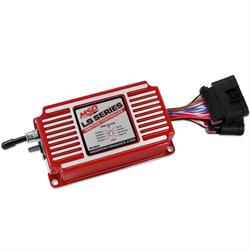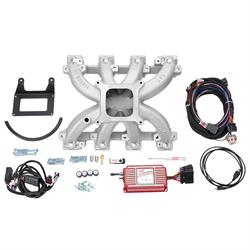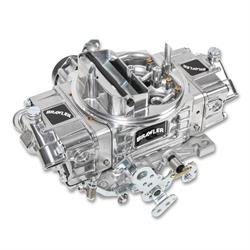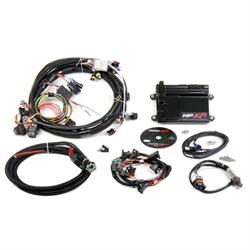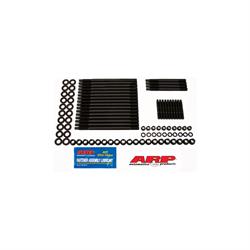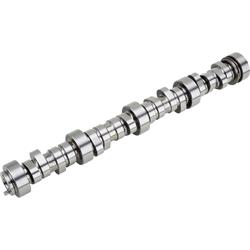Vortec 4.8 LS Build: Horsepower Recipes, Specs, & Upgrades
It’s been nearly 30 years since the first LS engine debuted under the hood of the 1997 Corvette. In that time countless thousands of LS swaps have been seen in all manner of cars and trucks. From the original LS1 to Vortec, Gen IV, and even LSX derivatives, there is no denying the unwavering popularity of the LS swap. In this guide we’re going to focus on the Vortec 4.8 LS found in many GM trucks, vans, and SUVs like the Tahoe, Silverado, and Express. These iron block 4.8 LS engines are often bypassed at the salvage yards for those looking for more displacement with the popular aluminum block 5.3 LS and 6.0 LS engines, but the 4.8 Vortec LS is no slouch and is a veritable salvage yard bargain score! Let’s not forget that many prefer iron block vs aluminum block LS engines for boosted 4.8 LS applications as well.
Is a 4.8 LS a Good Motor? | 4.8 LS Horsepower & Specs
The 4.8 Vortec LS engine was GM’s truck engine version (along with the 5.3L LS) of the 5.7L LS1. These smaller displacements were designed to replace the Gen II 305 and 350 Chevy V8 truck engine applications, respectively. Utilizing the same Gen III LS block and heads with different internals (crank and rod dimensions) provided an easy way for GM to change displacement without casting up different blocks. Therefore, the 4.8 LS is technically no different than it’s 5.3 or 5.7 siblings in the reliability department. That also goes for LS engine parts availability and performance potential. If anything, the 4.8 LS is sometimes preferred, as they were never built with Active Fuel Management (AFM), so there’s no AFM components and their high failure rates to worry about. Add in the fact that you can often score a 4.8 LS at the salvage yard for as little as $200 in most cases since they are so plentiful, making it the cheapest LS engine you can find. It is easy to see this little 293.3ci LS (according to our engine displacement calculator) makes for great budget LS swap fodder.
While we all want to make a lot of power, it is painfully obvious that the more displacement and factory horsepower you start with the more horsepower you can make with all other costs being the same (camshaft, rocker arms, intake, carb or EFI, etc.). So why recommend the “lowly” 4.8 Vortec junkyard LS engine? Well, besides the low cost of entry and the great availability, the Vortec 4.8 LS can make just as much power as the popular 5.3 LS everyone covets. With factory power ratings in the 250-300 horsepower range, it is not that uncommon to make 400 horsepower with a stock bottom end 4.8 Vortec build with the right parts. The main thing the Vortec 5.3 LS has going for it is better low speed torque, and frankly, you can gain most of that back in the Vortec 4.8 LS with a good cam swap. If you’re looking for a nice low-buck LS build for your LS swap project, and don’t have to have the biggest and baddest 6.0 LS, the 4.8 LS engine horsepower level can easily hit 400 plus horsepower with the stock heads! That 400 horsepower will feel great in a light vehicle like a hot rod or classic muscle car too and save you a lot of build budget.
The Vortec 4.8 LS specs are the same as the 5.3 LS engine specifications in many areas, such as the 6-bolt main caps, 3.780-inch bore, cylinder heads, intake, PCM, and more. The main differences will be in the rotating assembly (crank stroke and rod length), and the camshaft. The LS 4.8 bore and stroke is 3.780 by 3.267, while the LS 5.3 bore and stroke is 3.780 by 3.622. And since we know you’re probably thinking it at this point, yes, you can grab the 5.3 LS crank and rods and add them to the 4.8 Vortec LS block and make it a cheap 4.8 LS stroker, but it is only worth it if you have a bunch of free spare LS parts lying around, otherwise for the cost you might as well investigate a legit stroker kit. If you’re not sure what that is, be sure to read our What is a Stroker Engine Toolbox article for all the details.
What is an LS Engine? | LS VS Vortec
As noted above, the LS engine family launched in 1997 in the C5 Corvette. The LS is technically the third generation of GM’s small block V8. While still a cam in block design with overhead valves, it is vastly different than the Chevy small block many of us grew up with and which is referred to as a Gen I small block today. The Gen III LS (and later the Gen IV LS, which you can learn more about in our junkyard LS engine guide) have become extremely popular for engine swaps in all manner of vehicles due to their aluminum block weight savings, inherent strength for boosted applications, low cost, and huge aftermarket support. Our LS engine swap guide is a great resource for those jumping into their first LS swap project.
The Vortec V8 used in GM trucks and SUVs is not technically an LS engine. It is considered “LS based” since it uses much of the same architecture, however the Vortec truck engines use a cast iron block for durability and feature taller “truck intake” manifolds with longer runners to help produce more torque for these heavier vehicles. Wiring and other aspects are vastly different in their OEM application settings as well. That said, the Vortec family of engines, especially when it comes to the world of LS swapping, is, for all intents and purposes, an LS engine, and that is how we’ll refer to the Vortec V8 for the remainder of this guide.
How to Identify an LS Engine| LS LR4 | LS L20 | LY2 engine
When searching for a good used 4.8 LS engine for your LS swap it helps to know the original factory installed vehicles and model years. Below we have provided the basic engine specs, year/make/model applications, and VIN digits to help you find that diamond in the rough! Be sure to read up on our LS engines list for more LS engine ID tips and how to identify an LS engine both in and out of a vehicle.
Gen III LR4:
The Gen III LR4 LS is one of the earliest versions of the 4.8L LS engine and was used in trucks and SUVs from 1999 to 2006.
- Compression Ratio: 9.4:1
- Horsepower Rating: 255-280 hp
- Torque Rating: 285-295 ft./lbs.
- VIN 8th Digit Designator: V
- 1999-2006 Chevrolet Silverado 1500
- 1999-2006 GMC Sierra 1500
- 2000-2006 Chevrolet Tahoe
- 2000-2006 GMC Yukon
- 2003-2006 Chevrolet Express
- 2003-2006 GMC Savana
Gen IV LY2:
The Gen IV LY2 is another variant of the 4.8L engine that appeared in GM trucks and vans, particularly in the 2007-2009 model years.
- Compression Ratio: 9.1:1
- Horsepower Rating: 260-295 hp
- Torque Rating: 295-305 ft.-lbs.
- VIN 8th Digit Designator: C
- 2007-2009 Chevrolet Silverado
- 2007-2009 Chevrolet Tahoe
- 2007-2009 GMC Sierra
- 2007-2009 GMC Yukon
- 2008-2009 Chevrolet Express
- 2008-2009 GMC Savana
Gen IV L20:
The Gen IV L20 is a version of the 4.8L engine designed for flexible-fuel capability, allowing it to run on ethanol-based E85 fuel from 2010 to 2014.
- Compression Ratio: 8.8:1
- Horsepower Rating: 260-302 hp
- Torque Rating: 295-305 ft.-lbs.
- VIN 8th Digit Designator: A
- 2010-2014 Chevrolet Silverado
- 2010-2014 GMC Sierra
- 2010-2014 Chevrolet Express
- 2010-2014 GMC Savana
4.8L LS Block Casting Numbers:
Block casting numbers are one way to confirm what you’re looking at if the engine is no longer in the vehicle. The LS engine block casting numbers are found on the passenger side of the block at the rear of the casting, just above the transmission bellhousing flange.
LR4 engine (1999-2006):
- 12567392
- 12567393
- 12551358
LY2 engine (2007-2009):
- 12576177
- 12576178
- 1589779
L20 engine (2010-2014):
- 12576177
- 12576178
- 1589779
4.8 LS Build | How Much HP Can a 4.8 LS Handle
The 4.8 LS engine is one of the smaller displacement options within the LS family, but it still has significant potential for performance when properly built and tuned. The amount of horsepower a 4.8 LS engine can handle depends on several factors, including the specific components used in the build, the level of modification, and the intended application. However, with the right upgrades and tuning, it's possible to achieve impressive power levels from a built 4.8 LS engine horsepower wise. It is not unheard of to have a built 4.8 LS build make more than 400 horsepower and can even make over 500 horsepower with a power adder.
Internal Upgrades:
While obviously a camshaft upgrade is mandatory to get any real power out of the 4.8 LS, if you’re looking to add boost or have a high rpm operating window (or both!), then further internal upgrades like a forged crankshaft and connecting rods, aftermarket cylinder heads, and other pieces are the key to power production and longevity. Increasing compression, displacement, and efficiency are all key to making more power with L20 engine parts.
Forced Induction:
Boost can be addictive, so whether it is a large single turbo, twin turbos, or a supercharger, you must keep boost levels in check. For a stock bottom end 4.8 LS we recommend no more than 8 psi. While the 4.8 LS rod ratio favors boost and is a bit “safer” than the 5.3 LS, the rods are still powdered metal design with meager rod bolts. That said, if you want to go with a better forged rod on the stock crank and quality rod bolts, you can get away with more boost. Know that the pistons will still be the weak spot, which is why those looking into double digit boost numbers usually do crank/rods/pistons.
Fuel System and Tuning:
For NA applications the stock fuel rails and injectors are close to their limits. Even something like a hot cam swap we’d recommend higher flowing fuel injectors, a bigger fuel pump, and of course some good tuning. Fuel rails help too with fuel volume to the injectors, and often are required with aftermarket intakes, as the stock rails do not always mount easily to these intakes.
Cooling and Lubrication:
Modern engines are designed to run at a hotter temperature. That said, you still need to control your LS swap’s cooling properly with a LS “friendly” radiator to support the LS steam line. An external oil cooler and even an aftermarket oil pan are all beneficial to keeping your LS in the proper operating zone temperature wise.
Exhaust System:
Many will say that they install a high-flow exhaust system or long tube headers for the sound, and there is some truth to that. We all love a deep, aggressive exhaust note on our hot rods and muscle cars. But the truth is, that larger diameter tubing and high-flow mufflers all help with exhaust efficiency, which contributes to your horsepower bottom line. Not to mention, most LS swaps the stock exhaust manifolds will have fitment issues and you’ll need LS swap headers for your chassis.
How to Get More Power Out of a 4.8 Vortec | Bolt On 4.8 Vortec Upgrades
The 4.8 LS responds no differently than it’s larger displacement brothers when it comes to bolt on performance upgrades like headers, cold air induction, and other bits for a nice bump in power without any internal upgrades other than perhaps a camshaft. Look at some of these bolt-on performance parts options and note which may be right for your build and start making some easy power.
- Cold Air Intake (Estimated HP Gain: 5-15 HP): A cold air intake allows your engine to breathe in cooler, denser air, resulting in improved combustion and increased horsepower.
- 4.8 LS Headers (Estimated HP Gain: 10-20 HP): Upgrading to aftermarket headers improves exhaust flow, reducing backpressure and increasing horsepower.
- Cat-Back Exhaust System (Estimated HP Gain: 5-15 HP): Installing a high-flow cat-back exhaust system further enhances exhaust flow, contributing to horsepower gains.
- 4.8 LS Camshafts (Estimated HP Gain: 20-40 HP): Upgrading to a performance camshaft optimizes valve timing and lift, increasing airflow and horsepower.
- Aftermarket PCM (Estimated HP Gain: 10-20 HP): Replacing the factory engine powertrain control module (PCM) with a unit that allows custom tuning optimizes fuel and ignition timing, unlocking hidden horsepower.
- High-Flow Fuel Injectors (Estimated HP Gain: 5-15 HP): Upgrading to high-flow fuel injectors ensures adequate fuel delivery for increased horsepower.
- Upgraded Ignition Coils and Spark Plugs (Estimated HP Gain: 5-10 HP): Upgrading ignition coils and spark plugs improves combustion efficiency, resulting in smoother engine operation and potential horsepower gains.
- Performance Intake Manifold (Estimated HP Gain: 10-20 HP): Upgrading to a performance intake manifold improves airflow to the cylinders, increasing horsepower and torque.
LS 4.8 Turbo Tips
Tossing a turbo (or two!) onto an LS engine is one of the easiest and fastest ways to make big power with an LS swap. Volumes have been written about LS turbo kit builds, so we’re just going to cover the basics here to get you started if turbo kits for LS are something you are considering.
LS 4.8 turbo setups will use the same turbo manifolds or headers as a typical 5.3 LS turbo build. However, if you compare the 4.8 LS specs to the 5.3, it has a more favorable rod ratio and 12 degrees of piston dwell time, making it a great candidate for a turbo. More so than the 5.3 LS to be honest. Most LS swaps using a single turbo setup will be easier to plumb the hot side with cast iron manifolds, but turbo headers are the best option for twin turbo builds. Factoring the correct turbo size for your needs/application, wastegate spring settings, and if an intercooler is being plumbed all affect boost levels. Turbo builds are a lot of fun and can be put together on a tight budget, but tuning is imperative to keeping the insides of your built 4.8 LS on the inside of your block!
While we’re talking about turbos, we’d be remiss in not providing a quick mention about nitrous oxide. Most LS Nitrous kits use throttle body adapter plates to inject the nitrous and additional fuel into the intake for more power. Nitrous is a cost effective way to make quick power, often anywhere from 150-250 horsepower, with the main detriment being having to refill the bottle when it’s empty (or owning multiple bottles to swap out). The nitrous kit can be used to complement a turbo setup very well, acting as a “chemical intercooler” to cool the heated compressed air coming from the turbo if you do not have the room to mount and plumb an intercooler. A small nitrous kit can also help offset a turbo that is too large, creating power down low until the turbo “catches up.” Several things to consider, including additional tuning needs, nitrous controllers, ignition, and more, but when properly setup, a turbocharged LS with a bit of the “sauce” on top is one potent ride.
4.8 LS High RPM Build
If you’re the type that loves to use all the tach since you paid for all the tach, then perhaps the 4.8 LS is the right LS build for you. You see, not only is the rotating assembly lighter than other, larger LS engines, but the shorter crank stroke of the 4.8 LS (nearly 3/8-inch shorter stroke than the 5.3 LS) means it is easier to spin up to 7,500 rpm. Something that’s impossible to do with your typical small block Chevy of years past without major work and expensive parts. The lighter rotating assembly and shorter stroke mean that the 4.8 LS is more responsive to throttle input and can withstand those runs to the top of the tach time and time again without stressing the engine’s internals. Not to mention that there are plenty of LR4 4.8 performance upgrades to help achieve consistent and reliable high rpm performance.
Cheapest LS Engine to Build | 4.8 VS 5.3 VS 6.0
A lot of bench racing conversations have been had about LS engines over the years and many of them have been about the displacement differences and which may be the best LS engine to build. It’s easy to go for the 6.0 LS; go big or go home, right? But there is more to these three LS engines to compare than simply how many cubes, er, liters they are. So, let’s break down the talking points and then we’ll compare the 4.8 LS to each other.
Displacement
While the 4.8 is the smallest, it is also considered the least desirable, making for an incredibly low cost of entry for an LS swap. The 4.8 suffers a bit on torque down low, but performance wise can be made to easily surpass the 5.3 in peak power making. The 5.3 is a nice step up in displacement and potential, but with additional cost. While the 6.0 is the most expensive engine in the salvage yard, dinging your LS swap budget, it does have that displacement going for it.
Cost of Engine
While we touched on this briefly above, it is worth reiterating that the 4.8 LS is going to be the lowest cost of entry into the LS swap world and is nothing to be embarrassed about having under hood. The 5.3 has more power potential and a higher cost, while the 6.0 has even more potential and comes at an even higher cost. As we said at the very beginning, what are your plans for your project? If you’re looking for a nice 350-400 horsepower LS swap for your muscle car, kit car, or hot rod, there’s no need to waste money on a more expensive LS engine starting point like the 5.3 or 6.0.
Aftermarket Parts Support
Since the LS engine family shares a lot of commonalities in dimensions, mounting points, and so forth, the abundant aftermarket support for the more popular LS engines trickles down to the 4.8 LS, providing all manner of performance options. The 5.3 LS is the clear winner here from a product support standpoint, but the majority of what you’ll find out there for the 5.3 will easily work on the 4.8 LS for power production, LS swapping, and more.
Performance Potential
This one is simple, more displacement means more horsepower potential. The 6.0 LS is the clear winner here. If you’re looking to make 1,000 horsepower with twin turbos, then build a 6.0 LS. But remember what we stated earlier, the 5.3 and even the 4.8 LS will easily make 400 plus horsepower with mere bolt-ons and live happily under the hood of your street cruiser, leaving cash in your project budget for other needs.
4.8 VS 5.3 LS
Comparing the 4.8 LS to the 5.3 LS is quite common. As the two most commonly available LS engines for LS swaps, they get a lot of attention focused on them. While the 5.3 LS is more desirable to most, the 4.8 LS should not be kicked to the curb without a second thought in our opinion. The 4.8 is much more readily available and at a lower cost, so point to the 4.8 in that regard. Both engines feature the same bore size and use many of the same parts internally and externally, so we’ll call that a draw. The crank stroke is where the displacement differences are, with the 4.8 having a shorter stroke (3.267” to the 5.3’s 3.622”), which means the 4.8 can twist to a higher rpm and get there more quickly as well. Another point to the 4.8.
Factory power ratings are surprisingly close, with the 4.8 in the 270-290 hp range and the 5.3 in the 270-305 hp range (depending on model year and application). We’d call that a draw as well. Both engines respond well to bolt on upgrades and especially performance camshafts, though the 5.3 does make do with more aggressive cam timing that the 4.8 isn’t happy with. So, the 5.3 gets a point there. Overall, the 4.8 isn’t a bad choice, just know that the 4.8 LS max hp level is going to be a bit less than its larger displacement brothers. Don’t let the Internet naysayers sway you away from using the 4.8 either. But if your heart is set on being a member of the 5.3 LS swap club, then check out our 5.3 LS engine guide for more details.
4.8 VS 6.0 LS
Now when it comes to comparing the 4.8 to the larger displacement 6.0 LS, much of what we said about the 5.3 LS rings true here as well. While the 6.0 LS has a bit higher output of 300-330 hp (again, depending on year and application) and averages about 70 more lb-ft of torque than the 4.8, the 6.0L version of the LS V8 is much harder to find and comes at a higher entry price than the 4.8. That higher price point and larger displacement is a great starting point for a big power LS build (so point to the 6.0 LS we suppose) but the 4.8 LS is a great starting point for an LS swap and easily makes more horsepower than a traditional Gen 1 small block Chevy for a lot less money. That’s a win-win in our book.
Don’t let the displacement differences talk you into spending more for a larger engine you might not need. The LS family is different than the old small block Chevy family. If you had a 305 or 307 you most definitely wanted to upgrade to a 350. With the LS architecture, their great factory aluminum heads, and roller cam setup, the 4.8 (293ci) vs the 5.3 (323ci) vs the 6.0 (366ci) isn’t a direct comparison. Is the 30 cubic inches worth nearly double the cost for the engine when considering a 5.3 over a 4.8? We don’t think so, especially if you’re going to mod the engine with a new cam and other performance parts. The 6.0, at 73 more cubes than the 4.8 is tougher to say no to, but those 73 extra cubes are going to cost you at the junkyard, and that’s if you can find one. If the 6.0 LS’s extra displacement sways your decision, then give our 6.0 LS engine guide a look for build ideas.




